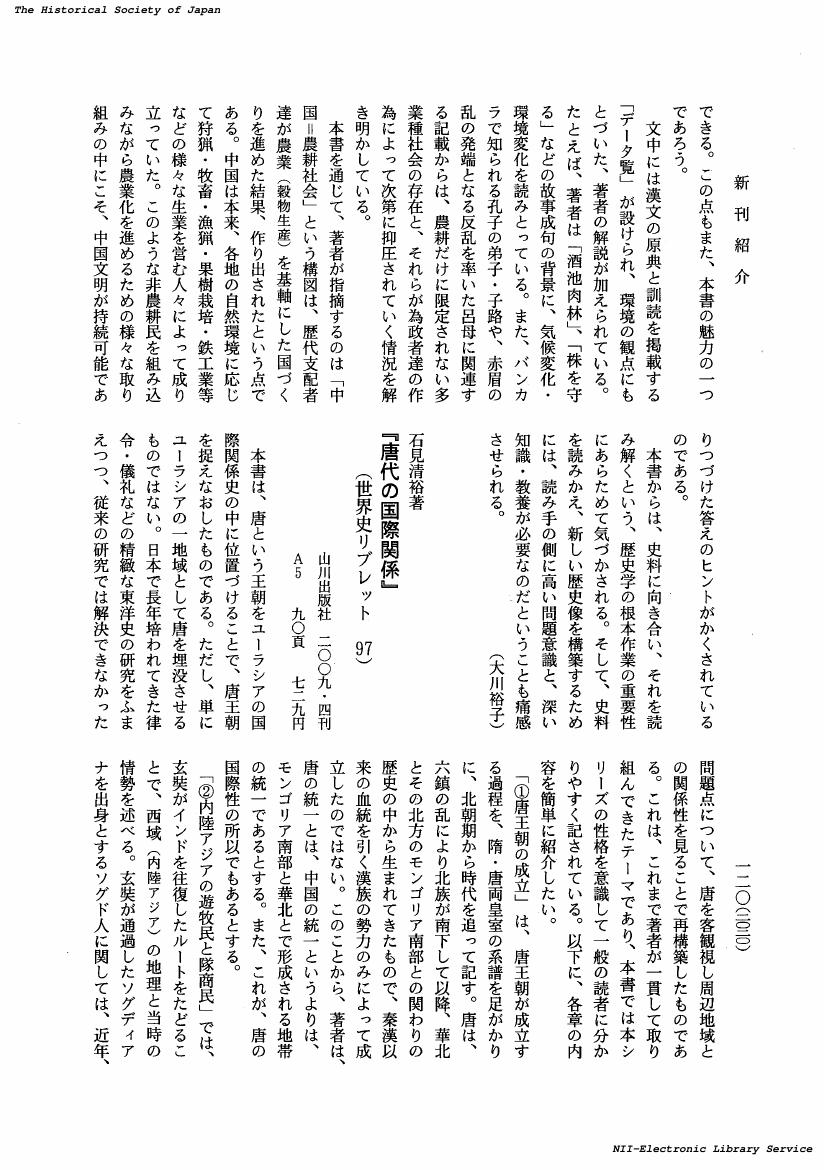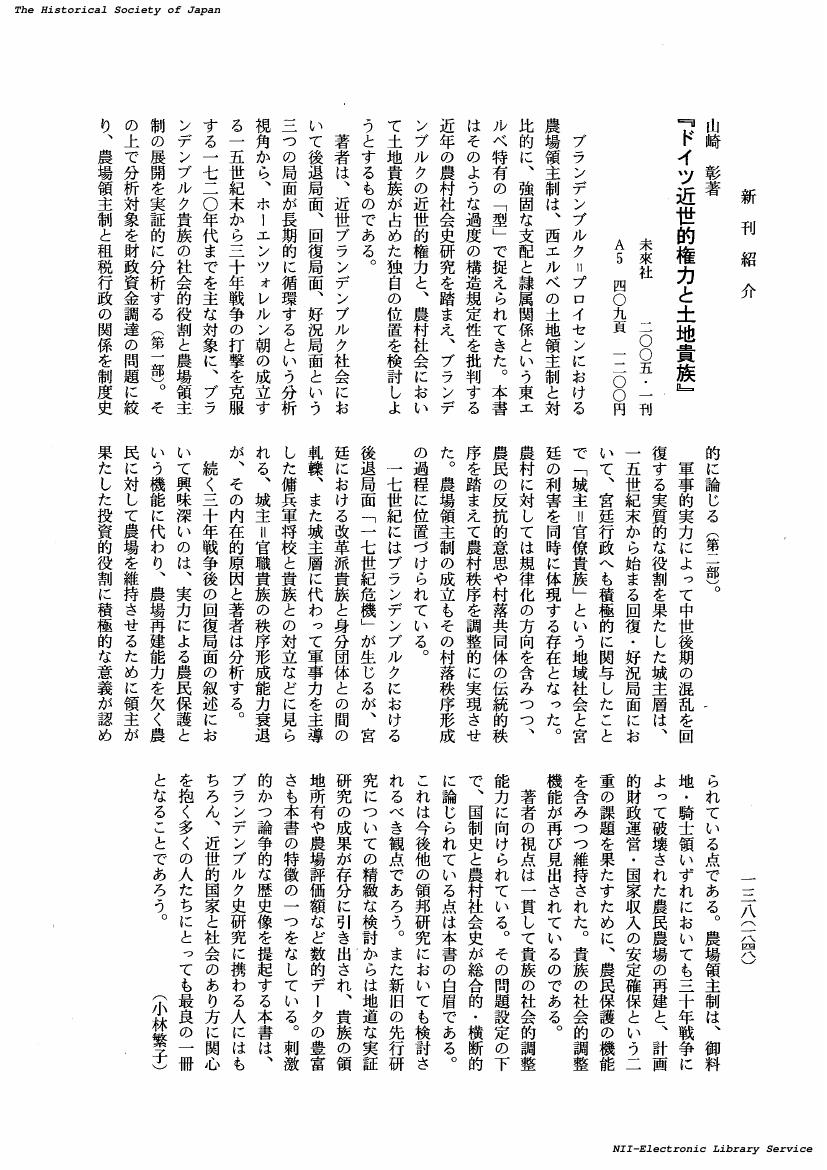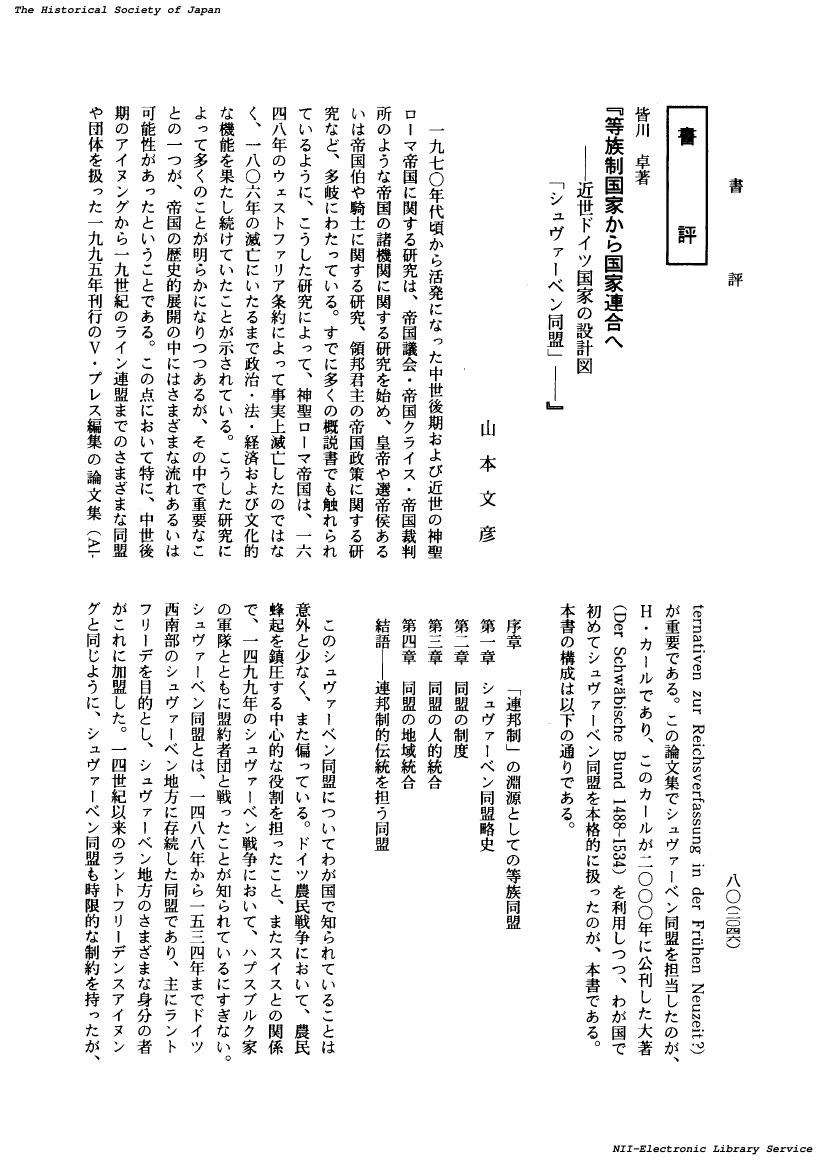1 0 0 0 OA 陶徳民・姜克實・見城悌治・桐原健真編, 『近代東アジアの経済倫理とその実践-渋沢栄一と張謇を中心に-』(渋沢栄一記念財団叢書), 日本経済評論社, 二〇〇九・三刊, A5, 二八八頁, 三八〇〇円
- 著者
- 黄 榮光
- 出版者
- 公益財団法人 史学会
- 雑誌
- 史学雑誌 (ISSN:00182478)
- 巻号頁・発行日
- vol.118, no.11, pp.2018-2019, 2009-11-20 (Released:2017-12-01)
- 著者
- 福島 恵
- 出版者
- 公益財団法人 史学会
- 雑誌
- 史学雑誌 (ISSN:00182478)
- 巻号頁・発行日
- vol.118, no.11, pp.2020-2021, 2009-11-20 (Released:2017-12-01)
1 0 0 0 OA 九条家本『神今食次第』所引の「内裏式」逸文について : 神今食祭の意義と皇后助祭の内実
- 著者
- 西本 昌弘
- 出版者
- 公益財団法人 史学会
- 雑誌
- 史学雑誌 (ISSN:00182478)
- 巻号頁・発行日
- vol.118, no.11, pp.1939-1963, 2009-11-20 (Released:2017-12-01)
This article introduces a complete description of the Kamuimake 神今食 ceremony as quoted in the Kujo Family version of Kamuimake Shidai held by the Imperial Household Agency's Department of Archives and Mausolea, in order to establish the date of the completion of the handbook on inner palace decorum (Dairigishiki 内裏儀式), explain the meaning of bedding in the ceremony and discuss the supporting role played by the empress. The author's investigation yields the following conclusions. 1. This new fragment of the Dairishiki not only 1) utilizes Tang Chinese names for various palace gates, which were officially adopted in the ninth year of the Konin 弘仁 era (AD 818), but also 2) records such dates as the sixth year of Konin and "during" the Daido 大同 era (806-810) and 3) mentions the ritual of haimu 拝舞 (praying and dancing), which seems to have been officially adopted in Konin 8. Therefore, the content of the fragment and the Dairishiki itself can be dated before Konin 9. 2. Turning to the Kamuimake ceremony itself, in which the Emperor "entertains" the god for the night, the fragment states, "The Imperial Clothiers supply the bedding and the emperor uses it," which has been noted as an important insight into the true nature of the first fruits ceremonies (Niinamesai 新嘗祭, and Daijosai 大嘗祭), but interpreted as a ceremony in which the emperor wraps himself in a futon coverlet, assumes the spirit of his ancestors, in a ritualistic consummation of marriage with his hand maidens (uneme 采女 and empress. However, the new fragment states that the emperor places the coverlet on the seat reserved for the god. Also, in the mythological origins of Kamuimake reflected by the story of Umihiko-Yamahiko, the gods who have come from afar are seated on mats piled eight high, feasted, and then married to their guests' daughters. Therefore, the Kamuimake ceremony of the Dairishiki should be understood as a divine marriage ceremony between the god and the imperial hand-maidens. 3. The research to date has been divided over the question of empress' involvement in such ceremonies as Kamuimake and Niiname. The new fragment clearly states that on the occasion of the Niiname ceremony of Konin 6 (815), Emperor Saga's empress Tachibana-no-Kachiko was transported to the ceremony hall (Sai'in 斎院). In the second month of Konin 11, a white silk garment was determined as the gown to be worn by the empress while she was assisting in ritual affairs, and the Engishiki 延喜式 revisions of the ritsuryo codes contain provisions for preparing futon coverlets and straw mats for use by the empress (Chugu 中宮) in the Kamuimake ceremony. These facts suggest that 1) the empress was outfitted personally for such ceremonies as Kamuimake and Niiname, 2) she attended the ceremony along with the emperor while he served wine and food to the gods and 3) assisted him in the prayer rituals. Therefore, the author argues that the Kamuimake ceremony did not symbolize the emperor assuming supernatural powers and ritually consummating marriage with his female staff. Rather, it involved inviting terrifying, potentially dangerous gods to seats of honor to enjoy the kingdom's fruits and the companionship of the emperor's "daughters," in prayer for the security of the state and the prosperity of its subjects. It has been generally accepted that the empresses of ancient Japan performed ceremonial functions along side the emperors, but doubts have been raised as to whether they so participated prior to the Heian period. The author is of the opinion that is was only during the early Heian period that empresses became involved in rituals in the manner indicative of their participation in the Kamuiwake ceremony. It was Emperor Saga who initiated the custom of empress participation in order to heighten the prestige of Empress Tachibana and thus legitimize of the succession of her son to the throne.
- 著者
- 難波 ちづる
- 出版者
- 公益財団法人 史学会
- 雑誌
- 史学雑誌 (ISSN:00182478)
- 巻号頁・発行日
- vol.118, no.11, pp.1963-1988, 2009-11-20 (Released:2017-12-01)
The purpose of this article is to discuss the propaganda developed by the French authorities in Indochina between 1940 and 1945, in particular under the Vichy regime, in the new context of 1) losing the War, 2) occupation of the mother country by the Germans, and 3) the Japanese presence in the colony, especially the relation to propaganda efforts being made by the Japanese. The local French government's extensive propaganda campaign in Indochina was based on the idea of a "national revolution" in order to legitimize colonial rule. However, the influence exerted on the campaign by the Japanese presence was both strong and diverse, as exemplified by the various French reactions, ranging from compromise and antipathy based on points of common interest to resistance and indifference to obstructive cooperation. The campaign itself clearly reflected the basic problems facing the French authorities in ruling Indochina at that time. The slogans frequently raised at the time indicate that the French government had been forced to reconsider and then adjust its assimilative and "modernist" colonial policy approach of the previous years, which assumed "universal" republicanism and the introduction of necessary institutions for its implementation. Moreover, the French were powerless to deny the Japanese entry to the colonies, and in the midst of faulty maritime connections with the homeland, their claims of benefits to be derived from the "great French empire" soon proved ineffective in maintaining colonial authority. Having been forced to recognize the Japanese presence, the French had no alternative than to "accept" indigenous "values" and emphasize the bonds that tied Indochina to France. On the other hand, the Japanese propaganda hailing cultural attributes similar to the Indochinese, Asian solidarity, the gap that existed between East and West and superiority of Japanese leadership jolted the French campaign and weakened its effectiveness. In this sense, the appearance of a "Japanese factor" not only forced new developments to occur in French colonial policy, but at the same time hastened the end to French rule over the region.
- 著者
- 吉澤 誠一郎
- 出版者
- 公益財団法人 史学会
- 雑誌
- 史学雑誌 (ISSN:00182478)
- 巻号頁・発行日
- vol.116, no.10, pp.1687-1688, 2007-10-20 (Released:2017-12-01)
- 著者
- 斉藤 恵太
- 出版者
- 公益財団法人 史学会
- 雑誌
- 史学雑誌 (ISSN:00182478)
- 巻号頁・発行日
- vol.117, no.6, pp.1184-1185, 2008-06-20 (Released:2017-12-01)
- 著者
- 川西 孝男
- 出版者
- 公益財団法人 史学会
- 雑誌
- 史学雑誌 (ISSN:00182478)
- 巻号頁・発行日
- vol.117, no.1, pp.118, 2008-01-20 (Released:2017-12-01)
1 0 0 0 OA ドイツにおける「女性の運動」研究の変遷(研究発表,西洋史部会,第一〇五回史学会大会報告)
- 著者
- 姫岡 とし子
- 出版者
- 公益財団法人 史学会
- 雑誌
- 史学雑誌 (ISSN:00182478)
- 巻号頁・発行日
- vol.117, no.1, pp.120, 2008-01-20 (Released:2017-12-01)
1 0 0 0 OA ペーター・パンツァー/スヴェン・サーラ著, 『明治初期の日本-ドイツ外交官アイゼンデッヒャー公使の写真帖より-』, OAGドイツ東洋文化研究協会, 二〇〇七・八刊, A4, 四六〇頁, 五五〇〇円
- 著者
- 平野 達志
- 出版者
- 公益財団法人 史学会
- 雑誌
- 史学雑誌 (ISSN:00182478)
- 巻号頁・発行日
- vol.117, no.8, pp.1497-1498, 2008-08-20 (Released:2017-12-01)
- 著者
- 高津 秀之
- 出版者
- 公益財団法人 史学会
- 雑誌
- 史学雑誌 (ISSN:00182478)
- 巻号頁・発行日
- vol.117, no.8, pp.1499-1500, 2008-08-20 (Released:2017-12-01)
- 著者
- 小林 繁子
- 出版者
- 公益財団法人 史学会
- 雑誌
- 史学雑誌 (ISSN:00182478)
- 巻号頁・発行日
- vol.117, no.10, pp.1848, 2008-10-20 (Released:2017-12-01)
- 著者
- 山本 文彦
- 出版者
- 公益財団法人 史学会
- 雑誌
- 史学雑誌 (ISSN:00182478)
- 巻号頁・発行日
- vol.114, no.12, pp.2046-2054, 2005-12-20 (Released:2017-12-01)
- 著者
- 芦部 彰
- 出版者
- 公益財団法人 史学会
- 雑誌
- 史学雑誌 (ISSN:00182478)
- 巻号頁・発行日
- vol.115, no.4, pp.567-568, 2006-04-20 (Released:2017-12-01)
1 0 0 0 OA 望田幸男編, 『近代ドイツ=資格社会の展開』
- 著者
- 鎗田 英三
- 出版者
- 公益財団法人 史学会
- 雑誌
- 史学雑誌 (ISSN:00182478)
- 巻号頁・発行日
- vol.115, no.2, pp.227-234, 2006-02-20 (Released:2017-12-01)
- 著者
- 成川 岳大
- 出版者
- 公益財団法人 史学会
- 雑誌
- 史学雑誌 (ISSN:00182478)
- 巻号頁・発行日
- vol.113, no.12, pp.2081, 2004-12-20 (Released:2017-12-01)
- 著者
- 小澤 実
- 出版者
- 公益財団法人 史学会
- 雑誌
- 史学雑誌 (ISSN:00182478)
- 巻号頁・発行日
- vol.114, no.12, pp.2081, 2005-12-20 (Released:2017-12-01)
1 0 0 0 OA 外モンゴル自治政府の再興とその歴史的意義 : 臨時人民政府との関係を中心に
- 著者
- 橘 誠
- 出版者
- 公益財団法人 史学会
- 雑誌
- 史学雑誌 (ISSN:00182478)
- 巻号頁・発行日
- vol.113, no.10, pp.1689-1720, 2004-10-20 (Released:2017-12-01)
In Outer Mongolia, two governments, the Autonomous Government of Outer Mongolia under Bogd khaan and the Provisional people's Government under Mongolian People's Party, existed side by side in 1921. However, in the research on the "History of the Revolution", the former has been defined as "Ungern's Puppet" or completely ignored, leading to the latter dominating the reseach. This article intends to relativize the two governments, focusing on the former and demonstrating its political situation in Mongolia at that time. After the abolition of autonomy in 1919, movements to revive it rose in Outer Mongolia. When Ungern Sternberg attacked Urga, the Mongols supported him and the Autonomous Government was revived. The reason why the Provisional People's Government was formed immediately after the Autonomous Government's revival was because of the influence exerted by Soviet Russia. The People's Party denounced the Autonomous Government for being ruled by Ungern in an attempt,to justify the establishment of its own new government. However, the Autonomous Government continued its activities and did not lose its faculties as a "government" after Ungern's rout. In addition, the Mongolian People's Party, which had defeated Ungern and entered Urga, demanded that the seals of the ministries of Autonomous Government be handed over. However, this contradition reflected the position of both governments in Mongolia, namely, the Autonomous Government was regarded as the legitimate one at that time, while the Provisional People's Government was not generally recognized. The transfer of seals aimed to refute the legitimacy of the Autonomous Government. This article points out that the Autonomous Government was regarded as the legitimate one, and held the key position in Mongolia from it's abolishment to the establishment of the people's Government. The reason why the conventional research on "the Mongolian Revolution" does not deal sufficiently with Autonomous Government is to conceal the contradictions surrounding the establishment of the People's Government. In recent years "re-examination" is prevailing and this article is part of creating a new view of "the Mongolian Revolution".
- 著者
- 四日市 康博
- 出版者
- 公益財団法人 史学会
- 雑誌
- 史学雑誌 (ISSN:00182478)
- 巻号頁・発行日
- vol.113, no.12, pp.2078, 2004-12-20 (Released:2017-12-01)
1 0 0 0 OA ジャルグチ考 : モンゴル帝国の重層的国家構造および分配システムとの関わりから
- 著者
- 四日市 康博
- 出版者
- 公益財団法人 史学会
- 雑誌
- 史学雑誌 (ISSN:00182478)
- 巻号頁・発行日
- vol.114, no.4, pp.443-472, 2005-04-20 (Released:2017-12-01)
Jarruci is generally regarded as a judge; however, the post included not only judicial duties but also management of census registers and fiscal administration. Although the relation of census registers to jarruci has not attract researchers' attention to date, it is a matter of no small importance in the structural fabric of the Mongol Empire. In the Secret History of the Mongols, there is a description of the origin of jarruci. It seems that Cinggis Qan decreed to share out people to his clan and establish jarruci at a time. It shows that the jarruci's two duties were interrelation, that is to apportion qubi (assigned territories, people and possessions) shared out among the imperial princes and to try transgressors by jarru. The nomadic groups multilayeredly formed by sharing among the Cinggised lines and dominant noyans were called ulus. One ulus corresponded to each jarruci's jurisdictional limits. Jarruci's administrative role was closely connected to the structure of the Mongol Empire composed of multilayered uluses. From superordinate ulus to subordinate ulus, sharing olja (spoils) were shared as qubi. At the connecting points of such a multilayered social structure, jarruci apportioned qubi justly, and kept order among the ulus. Jarruci investigated olja and reported the results to the qan of his ulus, then carried out the apportionment of qubi as ordered by the qan. At the same time, jarruci were dispatched from subordinate ulus to superordinate ulus to ensure qubi of his ulus. Jarruci, in other words, redistributed qubi inside their own ulus and as a dispatched offical ensured qubi outside their own ulus. Ulus and ulus, sedentary territories and nomadic territories were connected by jarruci, and thereby the Mongol Empire was able to maintain a certain degree of uniformity as a single state.
- 著者
- 山本 佐門
- 出版者
- 公益財団法人 史学会
- 雑誌
- 史学雑誌 (ISSN:00182478)
- 巻号頁・発行日
- vol.113, no.4, pp.523-530, 2004-04-20 (Released:2017-12-01)















